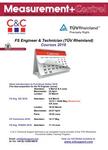版权所有:内蒙古大学图书馆 技术提供:维普资讯• 智图
内蒙古自治区呼和浩特市赛罕区大学西街235号 邮编: 010021

作者机构:Professor and Head School of Electronic Engineering South Australian Institute of Technology Ingle Farm South Australia
出 版 物:《Measurement and Control》 (Meas Control)
年 卷 期:1981年第14卷第7期
页 面:257-259页
核心收录:
学科分类:08[工学] 080203[工学-机械设计及理论] 080401[工学-精密仪器及机械] 0804[工学-仪器科学与技术] 0802[工学-机械工程] 081102[工学-检测技术与自动化装置] 0811[工学-控制科学与工程]
摘 要:Mechanical mathematical mechanisms are those in which the mechanical input signal bears a known and adequately held common mathematical relationship with the output signal. They are a special class of mechanism in which normal precision design complements additional requirements for mathematical operation. They largely find competitive application with electronic alternatives in situations where the number of function relationships required is relatively small and where electrical power is not readily available for electronic data processing circuitry. In this case the mechanical input to the instrument provides the energy to actuate the mechanism. In some applications the mechanical method can provide greater reliability. Mechanical mechanisms generally fail to give proper operation through gradual deterioration of the accuracy which steadily falls with wear. Electronic equivalents, unless built with redundancy arrangement, will generally fail absolutely and often catastrophically. Part B of the paper describes the basic (mechanical) function elements to perform addition, subtraction, multiplication, division, differential addition/subtraction, multiplication-by-a-constant, squares, square-roots, and square-roots of products, function generation, and integration.